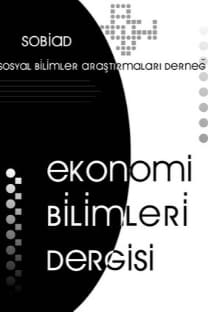YARATICI EKONOMİ YAKLAŞIMI ÇERÇEVESİNDE ÜNİVERSİTE ÖĞRENCİLERİNİN SOSYAL SERMAYE SEVİYESİNİN BELİRLENMESİNE YÖNELİK BİR ANALİZ
Bölgesel kalkınma yaklaşımlarından olan yaratıcı ekonomi yaklaşımının itici gücünü yaratıcı sınıf oluşturmaktadır. Yüksek eğitim almış kişilerin oluşturduğu yaratıcı sınıfın kalite ve etkinliğinin artırılması bölgesel kalkınmayı da artıran bir etmen olacaktır. Sosyal sermaye olgusu tıpkı yaratıcı ekonomi gibi kalkınma literatüründe nispeten yeni bir kavram olmakla beraber, özellikle beşeri sermaye ve insani kalkınmaya olan etkileri bakımından hayati bir rol üstlenmektedir. Sosyal sermaye bakımından gelişmiş olan yaratıcı sınıf bölgesel kalkınmada öncü bir rol üstlenecektir. Çalışmada üniversite öğrencilerinin sosyal sermaye seviyeleri frekans analizi yöntemi ile ölçülmüş ve analiz edilen öğrencilerin tolerans seviyelerinin ve bölgesel bağlılıklarının yeterli düzeyde oldukları ancak özellikle güven ve ağ-bağlantıları bakımından sosyal sermaye yapısının eksik yetersiz olduğu görülmüştür. Üniversite öğrencilerinin güven ortamına kavuşmasını ve ağ-bağlantıları kurmalarını sağlayıcı politikalar uygulanarak sosyal sermaye seviyesi artırılabilir. Böylece yaratıcı sınıfın kalite ve etkinliği artırılarak bölgesel kalkınmada ivme kazanılabilecektir.
Anahtar Kelimeler:
Sosyal Sermaye, Sosyal Sermaye Endeksi, Yaratıcı Ekonomi, Yaratıcı Sınıf
AN ANALYSE FOR DETERMINING SOCIAL CAPITAL LEVEL OF UNIVERSITY STUDENTS IN THE CONTEXT OF CREATIVE ECONOMY APPROACH
Creative class is the driving force of creative economy approach as a regional development policy. If the quality and effectiveness of higher educated creative class will be increased, regional development level will be increased. Although social capital is a new phenomenon in development literature as creative economy, it has critical roles on human capital and human development. Creative class with a high level social capital will have a advance role in regional development. Social capital level of university students are measured by frequency analyse in the study. As a result of analyse, it is seen that, tolerance level and regional loyalty of university students are sufficient but there are shortages of thrust level and network capabilities. Social capital level of university students can be increased by using thrust and network capability promoting policies. By this way, quality and efficiency of creative class will be increased and regional development will gain acceleration.
Keywords:
Social Capital, Social Capital Index, Creative Economics, Creative Class,
___
- Arı hareketi, (2005), “Türk toplumu ve Sosyal Sermaye”, [http://www.ari.org.tr/index_tr.asp], Erişim: (04/03/2015).
- Chiristoforou, A., (2006), “Social Capital, Economic Growth and Human Development: An Empirical Investigation across European Countries”, The Annual Meeting of the Human Development and Capability Association, Freedom and Justice, [http//www.hdca.org/pubs/6_1_Christoforou.pdf.], Erişim (11/03/2015).
- Coleman, J. S., (1988) “Social Capital in The Creation of Human Capital”, American Journal of Sociology, (94/94), 95–120.
- Erselcan, F., (2009), Sosyal Sermaye ve Ekonomik Kalkınma: Sivas, Kayseri, Yozgat Bölgesinde Bir Araştırma, Doktora Tezi, Cumhuriyet Üniversitesi Sosyal Bilimler Enstitüsü, Sivas.
- Fidrmuc, J. And Gerxhni, K., (2007), Mind the Gap! Social Capital, East and West, Centre for Economic Development Institutions, London.
- Filiztekin, A.,(2009), Türkiye İçin Bir Rekabet Endeksi, EDAM ve Deloitte Türkiye Ortak Yayını, [http://www.edam.org.tr/images/PDF/yayinlar/Reports/t%FCrkiye%20icin%20bir %20rekabet%20endek si.pdf.], Erişim: (08/06/2015).
- Florida, R., (2005), Cities and The Creative Class, Routledge Publications, New York, USA.
- Hansen, H. K., (2007), “Technology, Talent and Tolerance – The Geography of the Creative Class in Sweden”, Lund University Department of Social and Economic Geography Report, No. 169.
- Howkins, J., (2001), The Creative Economy, The Penguin Press Publications, London, England.
- Kaldaru, H. ve Parts, Eve., (2005), “The Effect of Macro-level Social Capital on Sustainable Economic Development”, University of Tartu Faculty of Economics and Business Administration Working Paper, 42, 1-46.
- Karagül, M. ve Akçay, S., (2002), “Ekonomik Büyüme ve Sosyal Sermaye: Ampirik Bir Kanıt”, İktisat, İşletme ve Finans, (17/198), 82-90.
- Karataş, İ. ve Seki, İ., (2017), “Sosyal Sermaye ve Bölgesel Kalkınma İlişkisi: Aksaray Örneği”, Ege Akademik Bakış, (17/1), 105 – 126.
- Milani, C., (2003), “Social Capital and Local Development Theories: Lessons from the Pintadas Experience”, [http//www.adm.ufba.br/capitalsocial/…/ISTR%202003%20English%20version. Pdf], Erişim: (09/03/2015).
- National Statistics, (2001), “Social Capital a Review of the Literature”, Social Analysis and Reporting Division Office for National Statistics, 1-45.
- Neira, I., Vazquez, E. and Portella, M. (2009), “An Empirical Analysis of Social Capital and Economic Growth in Europe (1980-2000)”, Social Indicators Research,(92/1), 111-129.
- OECD, (2001), The Well-Being of Nations: The Role of Human and Social Capital, Paris.
- Seki, İ., (2013), “The Role of Non-Government Organisations in Regional Development: Creative Economy Approach”, 8th International NGO’s Conference, 25 – 26 October, Çanakkale.
- Seki, İ. ve Karataş, İ., (2016), Kalkınma Zincirinin Kayıp Halkası Sosyal Sermaye, Dora Basım-Yayın, Bursa.
- UNCTAD, (2008), Creative Economy Report The Challenge of Assessing The Creative Economy: Towards Informed Policy Making, UNCTAD Publications, New York, USA.
- World Bank, (1998), “The Initiative on Defining, Mentoring and Measuring Social Capital: Overview and Program Description”, Social Capital Initiative Working Paoer, No. 1, 1-33.
- Zak, J. P. and Knack, S., (2001), “Trust and Growth”, Economic Journal, Royal Economic Society, (111/470), 295-321.
- ISSN: 1309-8020
- Yayın Aralığı: Yılda 2 Sayı
- Başlangıç: 2009
- Yayıncı: Sosyal Bilimler Araştırmaları Derneği
Sayıdaki Diğer Makaleler
İLAÇ SANAYİNDE KÜRESELLEŞME VE STRATEJİK İŞBİRLİKLERİ
Eda AYDIN GÜLDÜR, Gülbin ÖZÇELİKAY
BİR SOSYAL SERMAYE PROJESİ OLARAK TAKAS EV: EVDE ATIL BİR ŞEY KALMASIN
TÜRKİYE’DE SAĞLIK HARCAMALARININ KARŞILAŞTIRMALI ANALİZİ
TÜRKİYE’DE SOSYAL BELEDİYECİLİK FAALİYETLERİ ÇERÇEVESİNDE ANTALYA BÜYÜKŞEHİR BELEDİYESİ ÖRNEĞİ
